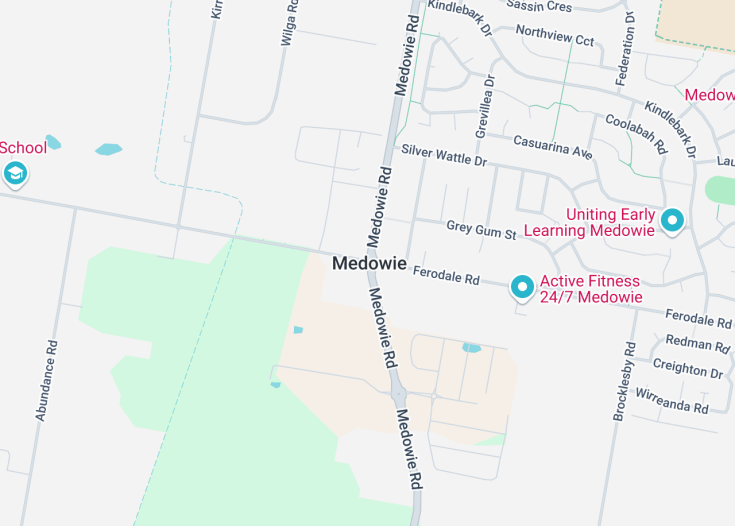Medowie, nestled in the heart of Port Stephens, Australia, presents a tranquil escape with its vast expanses of natural bushland and scenic landscapes. Ideal for nature lovers and those seeking peace away from city bustle, this charming suburb offers plenty of outdoor activities such as bushwalking, bird watching, and access to nearby beaches.
The community is warm and welcoming, providing a perfect blend of rural charm with essential amenities, making it an ideal destination for family trips or a serene getaway.
Explore the local bush trails early in the morning to experience the vibrant wildlife at its most active state.
Don’t miss visiting the nearby Grahamstown Lake, perfect for picnics and water sports.
Top things to do & see in Medowie
Select the following sights and activities to discover best tickets and tours available in Medowie.
Medowie: Gateway to the Hunter Region
| Country | Australia |
| Time in Medowie | GMT+10 |
| Language spoken | English |
| Population | 8,979 (source: latest census data) |
| Currency | Australian Dollar (AUD $) |
| Airports |
|
Medowie, located in the Port Stephens area of New South Wales, Australia, is a blend of both rural charm and developing urbanism. Known for its bushland and proximity to the Hunter Region’s vineyards, this town offers a peaceful yet connected lifestyle. Medowie’s history dates back to its original use by the Worimi people as a hunting ground. Today, it has evolved into a thriving community with a focus on family-friendly residential areas and local commerce. Recreational facilities and nature trails provide residents and visitors with ample opportunities for engagement and enjoyment.
Where is Medowie?
Medowie is situated in the Hunter Region of New South Wales, just north of the vibrant coastal city of Newcastle.
Distances:
| Route | Distance by car | Time by car |
|---|---|---|
| Newcastle to Medowie | 21 miles (34 kilometers) | 30 minutes |
| Sydney to Medowie | 111 miles (179 kilometers) | 2 hours 20 minutes |
| Canberra to Medowie | 280 miles (451 kilometers) | 4 hours 50 minutes |
What is Medowie famous for?
Medowie is renowned for its scenic landscapes, wildlife reserves, and proximity to the Hunter Valley, making it a favored destination for nature lovers and wine enthusiasts alike.
History
Pre-European Settlement
The area now known as Medowie, in the Port Stephens region of New South Wales, was originally inhabited by the Worimi people, one of several Aboriginal groups in the region. Rich in natural resources, the land provided bountiful hunting, fishing, and foraging opportunities, which supported a vibrant indigenous culture rooted in deep spiritual connections to the land.
1801-1845: Exploration and Early Settlement
European interest in the region began in the early 19th century, following the sighting by Captain James Cook in 1770. The first recorded European in the area was Lieutenant James Grant, who mapped parts of the coastline in 1801. The early settlers were primarily timber getters and farmers. In 1824, timber was being exported, and by 1830s, the establishment of agriculture steadily grew as settlers cleared the land for crops and livestock.
1846-1900: Development and Community Formation
As the settler population increased, so too did the infrastructure. Churches, schools, and stores were established as the community began to take shape. The latter half of the 19th century saw the growth of the dairy and timber industries, significantly contributing to the area’s economy and further promoting settlement.
1901-Present: Modern Developments
In the 20th century, Medowie continued to develop with the establishment of additional educational institutions, healthcare facilities, and residential areas. The region saw significant housing development during and after the Second World War, accommodating returning servicemen and their families. In recent years, Medowie has experienced a surge in residential development, appealing to those who prefer its quieter, rural setting while still being within commuting distance to Newcastle and other larger towns.
Visit Medowie
What to see and do in Medowie, Australia.
Medowie, nestled within the scenic beauty of Port Stephens, offers a blend of natural attractions, local cuisine, and community events that make it a unique destination. Top attractions include:
- The Medowie Nature Reserve, perfect for bushwalking and wildlife observation.
- Local markets showcasing artisan crafts and fresh produce.
- The nearby Grahamstown Lake, ideal for fishing and water sports.
- Various local cafes and eateries offering both traditional and contemporary Australian cuisine.
The town also offers various sports facilities and parks, catering to families and individuals looking for a leisurely day out.
Annual events in Medowie
Medowie comes alive with various annual events that draw both locals and visitors:
- The Medowie Macadamia Festival in March, celebrating the local nut production with food stalls, music, and family activities.
- The Port Stephens Literature Festival in September, where local and national authors converge to share and celebrate their work.
These events offer a deep dive into the local culture and are great opportunities to interact with the community.
Best time to visit Medowie
The best time to visit Medowie is during the spring (September to November) and autumn months (March to May). These periods offer pleasant weather, ideal for exploring the outdoor attractions and participating in local events. Additionally, the natural landscapes of the area are particularly vibrant during these times.
Is Medowie worth visiting?
Medowie offers a tranquil escape from the busier cities with its mix of natural beauty, local culture, and community spirit. While it may not boast the high-energy attractions of larger tourist destinations, its charm lies in its simple pleasures and the relaxation it offers.
Visitors looking for a slow-paced, nature-filled holiday will find it appealing. However, those seeking more dynamic activities or nightlife might find it less engaging. Accessibility might also be a challenge for those without personal transport, as public transport options are limited.









